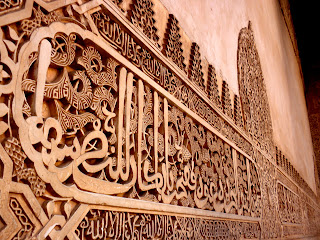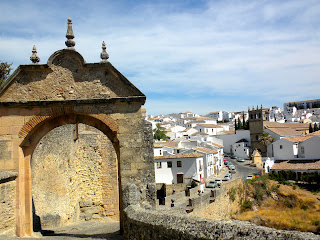 14N. HUELGA GENERAL. These are the two words and the date that now cover the city via graffiti and stickers. November 14th. General Strike.
14N. HUELGA GENERAL. These are the two words and the date that now cover the city via graffiti and stickers. November 14th. General Strike.Today I was supposed to have 3 classes; all but one were cancelled because my professors are on strike. One of my professors explained to me her reasons for protesting: in Spain, your salary is distributed so you get more during Christmas time and the summer, when you are likely to spend more. The government recently cut the Christmas salary, meaning that now people can't spend as much at Christmas time, which will in turn hurt small businesses. On top of this, they now have to work more hours per week, with the same reduced salary. And while this is happening to teachers, government workers voted to continue to travel in Business class rather than switching to economy, thus deferring the budget cuts away from themselves. This is why the teachers are protesting.
 As I left the school this morning, I ran into a group of 20 or so picketers, on their way to go make a racket inside our school.
As I left the school this morning, I ran into a group of 20 or so picketers, on their way to go make a racket inside our school.Around noon today began the main demonstration--a large rally through the main street of Granada. There were many different syndicates there, all handing out flyers as to what exactly they were protesting. One flyer listed these reasons:
Unemployment levels of over 25%
Increase in unjustified layoffs
1 in 5 Spaniards is in a situation of poverty
500 evictions per day
Cuts in public health, education, transportation, and mail
 Another called for action (which I have roughly translated to English):
Another called for action (which I have roughly translated to English):14 N. We call on you to participate in the Strike, to not work, to not consume, to interrupt the function of the city, to go out on the street and make of this day a day's work of optimistic, happy, and combative protest that targets the Government, the banks, the management and the Troika, sending the message that we are not capable of continuing to bear this and that we are ready to fight.

 We don't work
We don't workWe don't consume
We don't use public services.
Participate in the neighborhood pickets and rally, to inform and guarantee the right of the strike.
The rally itself was indeed optimistic, happy, and combative. It consisted of people of a wide range of ages (including children) and professions. Syndicates present included the CGT (General Confederation of Workers), USTEA (Union of Syndicates of Workers in Andalucía), and others. People carried banners, waved flags, and wore specially made T-shirts. A group of drummers made a lively beat. Kids played with noisemakers and vuvuzelas, parents carried their sleeping babies. Most small shops were closed; meanwhile the large businesses stayed open (Zara, an often-protested clothing company, for example). Many of the storefronts of these buildings were tagged in protest, and the ATM screens were spraypainted black.
Today there were protests all throughout Spain, and in other EU countries as well, according to the BBC (http://www.bbc.co.uk/news/world-europe-20320993).





































